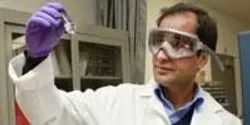Materials Science

An international collaboration with strong Aggie ties has figured out how to make a longer cotton fiber -- information that a Texas A&M University biologist believes could potentially have a multi-billion-dollar impact on the global cotton industry and help cotton farmers fend off increasing competition from synthetic fibers.

Lars Grabow has been given a $750,000 grant to solve a multi-billion dollar problem.

Researchers at the University of Delaware have developed a “smart” hydrogel that can deliver medicine on demand, in response to mechanical force.

Researchers at the Department of Energy’s Oak Ridge National Laboratory and the University of Tennessee, Knoxville have pioneered a new technique for forming a two-dimensional, single-atom sheet of two different materials with a seamless boundary.

Some come to Idaho to travel the highways that lead to the Tetons, to Yellowstone, to small towns and big adventures. Idaho National Laboratory researcher Isabella van Rooyen came, all the way from South Africa, looking for a piece of silver 500,000 times smaller than a poppy seed.

OAK RIDGE, Tenn., Dec. 16, 2013 – By controlling the temperature of silica rods as they grow, researchers at the Department of Energy’s Oak Ridge National Laboratory could be setting the stage for advances in anti-reflective solar cells, computer monitors, TV screens, eye glasses and more.

Physicists at the University of Chicago and the University of Massachusetts, Amherst, are uncovering the fundamental physical laws that govern the behavior of cellular materials

Who cares about old plastic? Researchers at the National Institute of Standards and Technology (NIST) do, so that you won’t have to years down the road, when today’s plastic concoctions start to break down and disintegrate from weather exposure. Experiments* at NIST may help scientists devise better tests to make sure aging plastics won’t turn into environmental or health hazards as time goes by.













